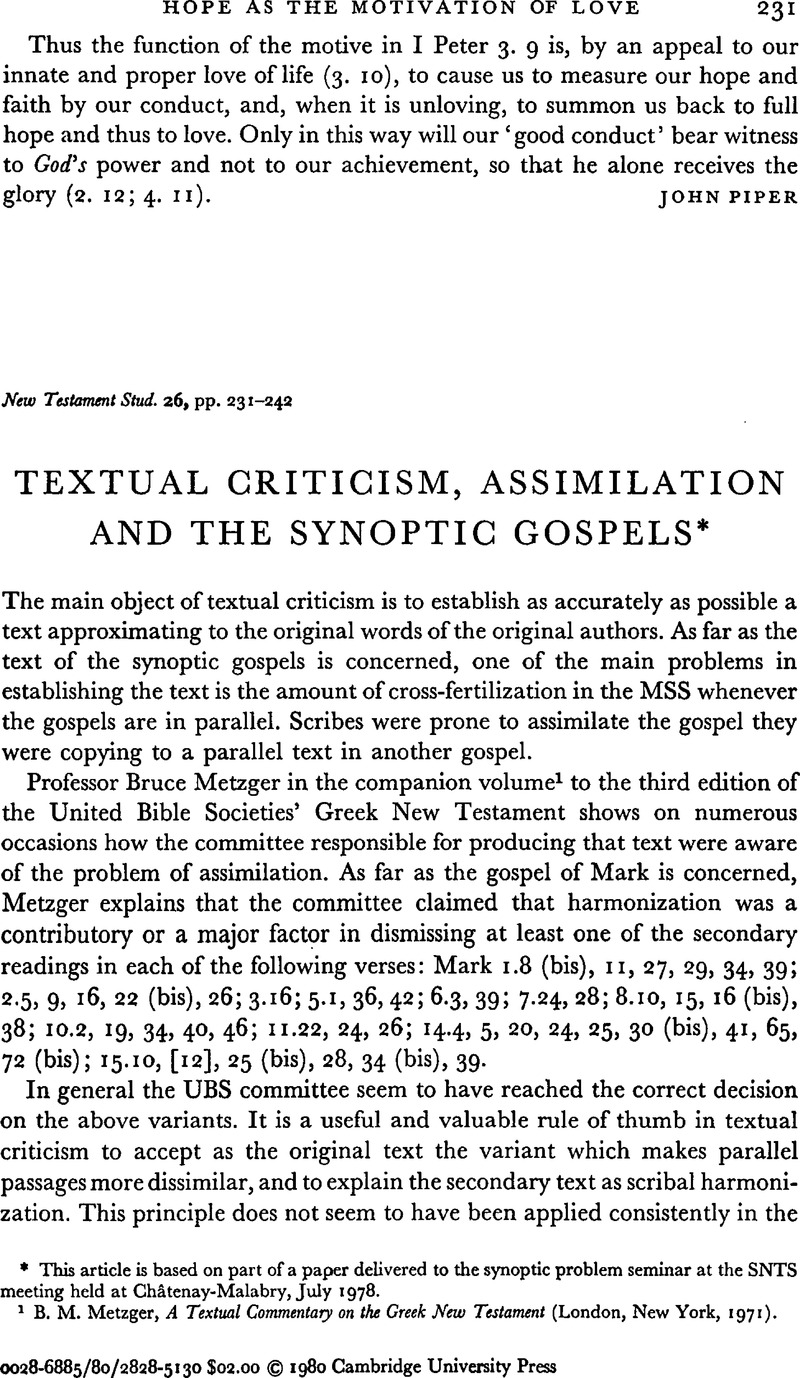Article contents
Textual Criticism, Assimilation and the Synoptic Gospels*
Published online by Cambridge University Press: 05 February 2009
Abstract

- Type
- Short Studies
- Information
- Copyright
- Copyright © Cambridge University Press 1980
References
1 Metzger, B. M, A Textual Commentary on the Greek New Testament (London, New York, 1971).Google Scholar
2 See further on the UBS text of Mark in Elliott, J. K., ‘An Eclectic Textual Commentary on the Greek Text of Mark's Gospel’ in the forthcoming Festschrift for Metzger, B. M. edited by Epp, E. J. and Fee, G. (Oxford).Google Scholar
3 Aland, K., Synopsis Quattuor Evangeliorum, 9th edition (United Bible Societies, 1975).Google Scholar
4 Neirynck, F., ‘The Synoptic Gospels According to the New Textus Receptus’, Ephemerides Theo-logicae Lovanienses 52 (1976), 364εíς σέ.Google Scholar
6 Syn8 assimilated Matt. to Luke which does not have τοīς but the issue is more involved than either edition of the Synopsis suggests: υ.l.adds τοīς in Luke. It must therefore be decided which gospel (s), if any, should have the article.
7 Again the position is more complicated. There are υ.ll. at Mark 10.25 and Luke 18.25 suggesting a great admixture. Here we are concerned only to indicate that the principles underlying Syn9 have given us a text which shows all three synoptics dissimilar.
8 υ. l. + οὖν in Mark here is likely to be secondary. There are only two firm instances of οũν in this gospel, although scribes sometimes inserted this particle to eliminate asyndeton. See Mark 12.9 below and also the section on asyndeton below, p. 240 f.
9 The longer text is characteristic of Markan tautology, cf. 12.23 where Syn9 adds (correctly) óταν ναστσιν albeit in brackets.
10 Further on this see Elliott, J. K., ‘Mathētēs with a Possessive in the New Testament’, Th.Z. (forthcoming).Google Scholar
11 See Elliott, J. K., ‘Nouns with Diminutive Endings in the New Testament’, Nov.T. 12 (1970), 391–8.CrossRefGoogle Scholar
12 Allen, W. C., International Critical Commentary on St. Matthew (Edinburgh, 1907).Google Scholar
13 Turner, C. H., ‘Marcan Usage: Notes, Critical and Exegetical on the Second Gospel’, J.T.S. in 10 parts between 1924 and 1928.Google Scholar
14 Turner, C. H., ‘Notes on Marcan Usage v’, J.T.S. 26 (1925), 225 f.Google Scholar
15 The brackets around ότι in Syn9 should be removed.
16 ότι is included in B L Δ. Syn9 lists only the MSS omitting ότι!
17 λλ at the beginning of a sentence is rare in Mark. The only exception is 13.24 within a poetic section of the apocalyptic discourse.
18 The verbs of speaking need to be decided here too, cf. also 10.29, 12.24 below. έφη is unlikely to be original at these places in Mark (similarly at Mark 9.12, 10.20, 14.29). See Kilpatrick, G. D. on the verbs of saying – most recently in ‘Some Thoughts on Modern Textual Criticism and the Synoptic Gospels’, Nov.T. 19 (1977), 275–92, especially p. 283.CrossRefGoogle Scholar
19 οũν is frequent in Matthew (60 times) and Luke (30 times) but rare in Mark. In Syn9 οὖν occurs 6 times in Mark (10.9; 11.31 bracketed; 12.9 bracketed; 13.35; 15.12; [16.19]. In Syn8 οũν is not bracketed at 11.31, therefore the brackets in Syn9 are a step in the right direction: but at 12.9 [οũν] has been added to the text so here Syn9 has moved in the wrong direction. Variants remove οũν in all the above places except 13.35 and 15.12. At 10.9 only D has the text without οũν. At 10.9; 11.31; 13.35, the parallel in Matthew has the particle {υ.l. omits at parallel to 11.31). The parallel to 11.31 in Luke has υ.l. + οũν (Luke 20.5).
- 3
- Cited by




